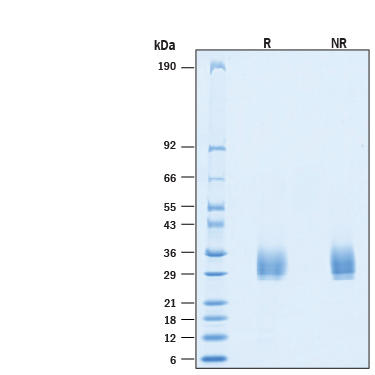Recombinant Human SOST/Sclerostin His-tag Protein, CF
Recombinant Human SOST/Sclerostin His-tag Protein, CF Summary
Product Specifications
Gln24-Tyr213, with a N-terminal 7-His tag
Analysis
Product Datasheets
Carrier Free
CF stands for Carrier Free (CF). We typically add Bovine Serum Albumin (BSA) as a carrier protein to our recombinant proteins. Adding a carrier protein enhances protein stability, increases shelf-life, and allows the recombinant protein to be stored at a more dilute concentration. The carrier free version does not contain BSA.
In general, we advise purchasing the recombinant protein with BSA for use in cell or tissue culture, or as an ELISA standard. In contrast, the carrier free protein is recommended for applications, in which the presence of BSA could interfere.
10962-ST
| Formulation | Lyophilized from a 0.2 μm filtered solution in PBS. |
| Reconstitution | Reconstitute at 500 μg/mL in PBS. |
| Shipping | The product is shipped at ambient temperature. Upon receipt, store it immediately at the temperature recommended below. |
| Stability & Storage: | Use a manual defrost freezer and avoid repeated freeze-thaw cycles.
|
Scientific Data
 View Larger
View Larger
2 μg/lane of Recombinant Human SOST/Sclerostin His-tag Protein (Catalog # 10962-ST) was resolved with SDS-PAGE under reducing (R) and non-reducing (NR) conditions and visualizedby Coomassie® Blue staining, showing bands at 25-35 kDa.
Reconstitution Calculator
Background: SOST/Sclerostin
Sclerostin (SOST) is a member of the Cerberus/differential screening-selected gene in neuroblastoma (DAN) family, a group of secreted glycoproteins characterized by a cysteine-knot motif. The Cerberus/DAN family consists of multiple members originally identified as putative BMP antagonists including Dan, SOST, Cerberus, Gremlin, USAG-1, PRDC, and Coco (1, 2). While the overall sequence identity between family members is low, they have conserved spacing of six cysteine residues in the C-terminus which form the structurally conserved cysteine-knot motif. Cerberus and Dan have an additional cysteine residue used for dimerization; however, SOST does not and is secreted as a monomer (1). Mature human SOST shares 90% amino acid sequence identity with mouse and rat SOST. SOST appears to be the first example of a BMP antagonist predominately localized to osteoclasts and functions as an important regulator of bone homeostasis by inhibiting bone mineralization (3). SOST has been shown to have unique ligand specificity by binding directly to BMP-5, -6, and -7 with high affinity and BMP-2 and -4 with low affinity thereby repressing BMP-induced osteogenesis (4). Mutations in the SOST gene can cause several bone dysplasia disorders characterized by progressive skeletal overgrowth including sclerosteosis and van Buchem disease (5). Additionally, SOST has been shown to be a strong Wnt antagonist by directly binding the Wnt co‑receptors LRP5 and LRP6 (6).
- Nolan, K. and Thompson, T.B. (2014) Protein Sci. 23:999.
- Balemans, W. et al. (2001) Hum. Mol. Genet. 10:537.
- van Bezooijen, R.L. et al. (2004) J. Exp. Med. 199:805.
- Kusu, N. et al. (2003) J. Biol. Chem. 278:24113.
- Brunkow, M.E. et al. (2001) Am. J. Hum. Genet. 68:577.
- Kim, J. et al. (2020) Nat Commun 11:5357.
FAQs
No product specific FAQs exist for this product, however you may
View all Proteins and Enzyme FAQsReviews for Recombinant Human SOST/Sclerostin His-tag Protein, CF
There are currently no reviews for this product. Be the first to review Recombinant Human SOST/Sclerostin His-tag Protein, CF and earn rewards!
Have you used Recombinant Human SOST/Sclerostin His-tag Protein, CF?
Submit a review and receive an Amazon gift card.
$25/€18/£15/$25CAN/¥75 Yuan/¥2500 Yen for a review with an image
$10/€7/£6/$10 CAD/¥70 Yuan/¥1110 Yen for a review without an image
